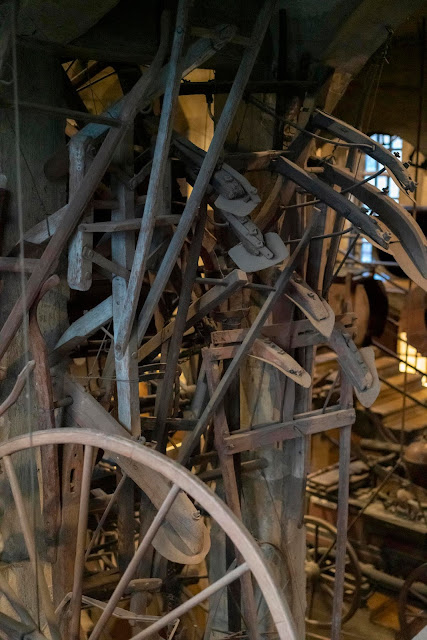I have decided to try to return to this blog after a gap of many years, coinciding with the pandemic and many other events. Stay tuned for new posts!
The Bushniks
Saturday, 16 March 2024
Tuesday, 14 January 2020
The Mercer Museum and Doylestown
While visiting family at Thanksgiving, we went to the Mercer Museum in Doylestown, PA. It was founded by Henry Mercer in 1916, and is housed in a reinforced concrete castle, designed by Mercer. Mercer was a devotee of the Arts and Crafts movement, and was obsessed with collecting all the tools and artifacts of pre-industrial American culture. What makes the museum special, though, is not just the artifacts that it contains, but rather the way in which they are assembled and displayed. Mercer wanted every possible variant of any tool; thus rather than, say, one shoe making tool, there are 30 or 40 different variants of each kind of tool, all numbered and on display in tiny little illuminated rooms that you can only see through their windows. Literally every square inch of the castle/museum is covered with stuff; even the ceiling has multiple objects hanging from it. The result is the ultimate clutter; I have never seen anything like it. It's like the giant attic of a man who could never throw anything way. It's a giant work of installation art, or even outsider art. It's kind of nice to see a museum which really doesn't try very hard to achieve its ostensible educational mission.
The exterior:
The center part of the museum is a seven story atrium, where you can see everything possible.
This is looking straight up, where things are hanging on the ceiling:
Some of the objects on display;
Doylestown itself is a wonderful small town, anchored by the fabulous County Theater:
The exterior:
The center part of the museum is a seven story atrium, where you can see everything possible.
This is looking straight up, where things are hanging on the ceiling:
Doylestown itself is a wonderful small town, anchored by the fabulous County Theater:
There are lots of old houses and even a nearby nature preserve.
Though this house is strangely dwarfed by the water tower behind it.
Monday, 11 November 2019
Day Trips From Bologna - Ravenna
A second highlight was a day trip to Ravenna, to see the mosaics. Ravenna was the capital of the Western Roman Empire in the 5th century, and for a brief period the rulers built elaborate churches that were decorated with mosaics in the interiors. For various reasons, these churches are now the best remaining examples of Byzantine mosaics in existence. It helps, of course, that mosaics are less fragile than paint. Again, there is nothing like seeing these mosaics in the churches that they were made for, because you see both the mosaics and the architectural space the were meant to be seen in. There are three or four main sites in the town. To me the most striking was the Basilica of San Vitale, with its beautiful octagonal interior. It was completed in the year 527, and combines elements of both Roman and Byzantine architecture. Again, I can't really photograph the architecture or the space, but I can photograph the mosaics.
Nearby is the very small Mausoleum of Galla Placidia, which was built around the same time. You can see the mosaics very well.

Inside:
The domed ceiling:
Detail:
In a museum, the small chapel of Sant'Andrea:
And finally, the Basilica di Sant'Apollinare Nuovo, which has a large, rectangular shape:



We saw this, the throne of an early pope, made out of carved ivory:
Subscribe to:
Posts (Atom)




































































